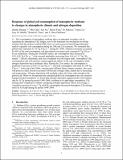| dc.contributor.author | Zhuang, Qianlai | |
| dc.contributor.author | Chen, Min | |
| dc.contributor.author | Xu, Kai | |
| dc.contributor.author | Tang, Jinyun | |
| dc.contributor.author | Saikawa, Eri | |
| dc.contributor.author | Lu, Yanyu | |
| dc.contributor.author | Melillo, Jerry M. | |
| dc.contributor.author | McGuire, A. David | |
| dc.contributor.author | Prinn, Ronald G | |
| dc.date.accessioned | 2014-03-14T16:05:26Z | |
| dc.date.available | 2014-03-14T16:05:26Z | |
| dc.date.issued | 2013-09 | |
| dc.date.submitted | 2013-05 | |
| dc.identifier.issn | 08866236 | |
| dc.identifier.uri | http://hdl.handle.net/1721.1/85627 | |
| dc.description.abstract | Soil consumption of atmospheric methane plays an important secondary role in regulating the atmospheric CH4 budget, next to the dominant loss mechanism involving reaction with the hydroxyl radical (OH). Here we used a process-based biogeochemistry model to quantify soil consumption during the 20th and 21st centuries. We estimated that global soils consumed 32–36 Tg CH4 yr−1 during the 1990s. Natural ecosystems accounted for 84% of the total consumption, and agricultural ecosystems only consumed 5 Tg CH4 yr−1 in our estimations. During the twentieth century, the consumption rates increased at 0.03–0.20 Tg CH4 yr−2 with seasonal amplitudes increasing from 1.44 to 3.13 Tg CH4 month−1. Deserts, shrublands, and xeric woodlands were the largest sinks. Atmospheric CH4 concentrations and soil moisture exerted significant effects on the soil consumption while nitrogen deposition had a moderate effect. During the 21st century, the consumption is predicted to increase at 0.05-1.0 Tg CH4 yr−2, and total consumption will reach 45–140 Tg CH4 yr−1 at the end of the 2090s, varying under different future climate scenarios. Dry areas will persist as sinks, boreal ecosystems will become stronger sinks, mainly due to increasing soil temperatures. Nitrogen deposition will modestly reduce the future sink strength at the global scale. When we incorporated the estimated global soil consumption into our chemical transport model simulations, we found that nitrogen deposition suppressed the total methane sink by 26 Tg during the period 1998–2004, resulting in 6.6 ppb higher atmospheric CH4 mixing ratios compared to without considering nitrogen deposition effects. On average, a cumulative increase of every 1 Tg soil CH4 consumption decreased atmospheric CH4 mixing ratios by 0.26 ppb during the period 1998–2004. | en_US |
| dc.description.sponsorship | United States. National Aeronautics and Space Administration (Land Use and Land Cover Change program (NASA-NNX09AI26G) | en_US |
| dc.description.sponsorship | United States. Dept. of Energy (DE- SC0007007) | en_US |
| dc.description.sponsorship | United States. Dept. of Energy (DE-FG02-06ER64320) | en_US |
| dc.description.sponsorship | United States. Dept. of Energy (DE-FG02-94ER61937) | en_US |
| dc.description.sponsorship | National Science Foundation (U.S.) (NSF-1028291) | en_US |
| dc.description.sponsorship | National Science Foundation (U.S.) (NSF Division of Information and Intelligent System (NSF-1028291)) | en_US |
| dc.description.sponsorship | National Science Foundation (U.S.) (NSF-0919331) | en_US |
| dc.description.sponsorship | National Science Foundation (U.S.) (NSF Carbon and Water in the Earth program (NSF-0630319)) | en_US |
| dc.language.iso | en_US | |
| dc.publisher | American Geophysical Union | en_US |
| dc.relation.isversionof | http://dx.doi.org/10.1002/gbc.20057 | en_US |
| dc.rights | Article is made available in accordance with the publisher's policy and may be subject to US copyright law. Please refer to the publisher's site for terms of use. | en_US |
| dc.source | Other univ. web domain | en_US |
| dc.title | Response of global soil consumption of atmospheric methane to changes in atmospheric climate and nitrogen deposition | en_US |
| dc.type | Article | en_US |
| dc.identifier.citation | Zhuang, Qianlai, Min Chen, Kai Xu, Jinyun Tang, Eri Saikawa, Yanyu Lu, Jerry M. Melillo, Ronald G. Prinn, and A. David McGuire. “Response of Global Soil Consumption of Atmospheric Methane to Changes in Atmospheric Climate and Nitrogen Deposition.” Global Biogeochemical Cycles 27, no. 3 (September 2013): 650–663. | en_US |
| dc.contributor.department | Massachusetts Institute of Technology. Center for Global Change Science | en_US |
| dc.contributor.department | Massachusetts Institute of Technology. Department of Earth, Atmospheric, and Planetary Sciences | en_US |
| dc.contributor.mitauthor | Zhuang, Qianlai | en_US |
| dc.contributor.mitauthor | Saikawa, Eri | en_US |
| dc.contributor.mitauthor | Prinn, Ronald G. | en_US |
| dc.relation.journal | Global Biogeochemical Cycles | en_US |
| dc.eprint.version | Final published version | en_US |
| dc.type.uri | http://purl.org/eprint/type/JournalArticle | en_US |
| eprint.status | http://purl.org/eprint/status/PeerReviewed | en_US |
| dspace.orderedauthors | Zhuang, Qianlai; Chen, Min; Xu, Kai; Tang, Jinyun; Saikawa, Eri; Lu, Yanyu; Melillo, Jerry M.; Prinn, Ronald G.; McGuire, A. David | en_US |
| dc.identifier.orcid | https://orcid.org/0000-0001-5925-3801 | |
| dc.identifier.orcid | https://orcid.org/0000-0003-2233-8945 | |
| mit.license | PUBLISHER_POLICY | en_US |
| mit.metadata.status | Complete | |
